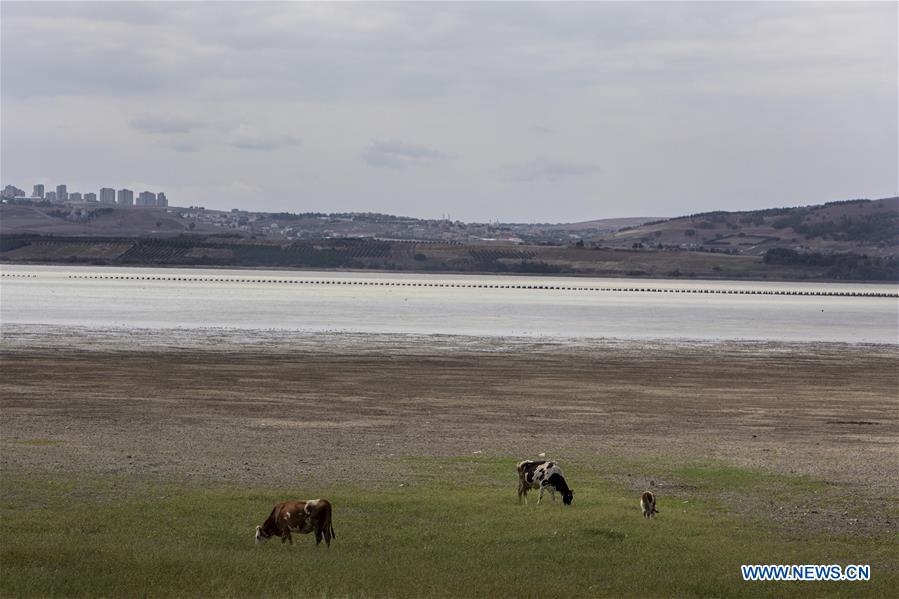
Photo taken on Sept. 21, 2020 shows the Buyukcekmece lake with exposed lake bed in Istanbul, Turkey. Turkey's giant metropolis Istanbul has been trying to cope with water shortage fueled by inefficient rainfalls and a dry summer season. The water level in nine different dams that have been supplying the city's needs has dropped to 40 percent as of Monday, down from 52 percent over the same period last year. (Photo by Osman Orsal/Xinhua)
ISTANBUL, Sept. 21 (Xinhua) -- Turkey's giant metropolis Istanbul has been trying to cope with water shortage fueled by inefficient rainfalls and a dry summer season.
The water level in nine different dams that have been supplying the city's needs has dropped to 40 percent as of Monday, down from 52 percent over the same period last year.
Having a population of over 16 million, Istanbul spreads over the Asian and European continents, which are divided by the 30-km-long waterway Bosphorus Strait, connecting the Marmara Sea in the south and the Black Sea in the north.
However, despite being surrounded by waters, local officials and related institutions have been grappling against a severe risk of water shortage this year as the long-expected abundant precipitation has not yet arrived in.
"We are currently trying to transfer water from the Asian side to the European part by establishing additional pumps as 65 percent of the entire water resources of the city is located on Asia," Raif Mermutlu, general manager of the Istanbul Water and Sewerage Administration (ISKI), told Xinhua.
Drawing the attention to the reverse correlation between the water resources in the two parts of the city and their population rate, Mermutlu said 65 percent of the Istanbul residents live in the European part.
"Therefore, we have to carry as much as water possible through the existing four pipelines from Asia to Europe to meet the high demand in the latter one," he said.
Additionally, the recent precipitation in the European part was significantly incompetent to fill the dams, according to Mermutlu.
Meanwhile, Istanbul Mayor Ekrem Imamoglu pointed out that the main focus of the city's water problem is the Melen Dam project, which has not become operational due to several setbacks since the construction began in 2012.
The project was launched to bring water from the Melen stream in the Sakarya province to Istanbul through pipelines.
"The dam will be finished in February 2023 at best," Imamoglu recently said, noting that it would further last two years to fill it with water. "So, if everything goes well, it will have about five years for the dam to be fully functional."
Mermutlu stated that Melen's annual capacity is 1.07 billion cubic meters, equivalent to the annual water consumption of Istanbul.
Due to the incomplete project, the ISKI was able to get only 50 percent of that capacity last year through the help of its own transmission means and pumps, he noted.
Meanwhile, Adil Tek, head of the Bogazici University Kandilli Observatory and Earthquake Research Institute Meteorology Laboratory, said the climate models showed that October and November would be dry as well in the region.
"We will see the rainfall in the form of floods, which would flow away from the surface without blending with the soil and feeding water resources," he said, according to press reports.
"If proper water policies are not implemented, serious problems will occur within a few years," Tek noted.
Orhan Sen, an academic at the Istanbul Technical University Meteorological Engineering department, said since the water catchment basins of Istanbul have been opened to urban construction projects, the rains could not interfere with the soil anymore.
"There is no green space left in the city. Therefore, rainwater runoffs to the seas or the sewer system," Sen was recently quoted as saying by the Milliyet daily.
"The unofficial population of the city is 20 million, and in fact, we need twice as much water than the current potential," Sen said, warning that if the drought continues, water levels will plummet even further next summer.
According to the latest data of the ISKI released on Monday, the water level in the Buyucekmece dam dropped to 19.83 percent and 11.64 percent in the Sazlidere dam both located on the European side of the city. Enditem



